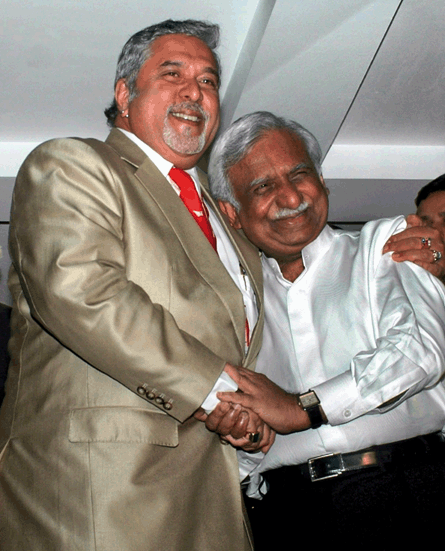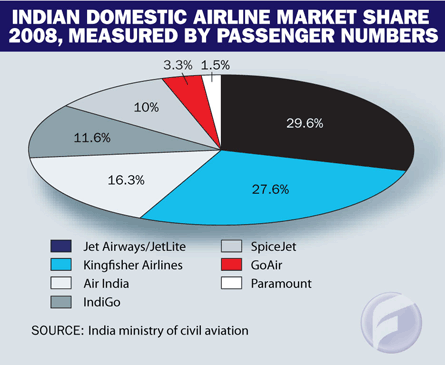Last year was one that India's airlines would probably like to forget ever happened. After years of phenomenal growth, fast-expanding carriers saw their cash reserves dry up as passenger demand weakened, putting the industry badly into the red.
Estimates vary widely on the extent of the losses, but the consensus is that India's carriers will collectively lose between $1 billion and $2 billion in the financial year to March. A dark cloud of pessimism is now hanging over the sector, with share prices depressed and the country's publicly traded airlines regularly posting dismal financial results, making it even tougher for them to raise badly needed cash.
"The global crisis in aviation is deepening. India is one of the epicentres, with potential losses of $1.5 billion this year," International Air Transport Association director general Giovanni Bisignani said recently of the performance of the Indian industry in 2008.
Bisignani added that this loss figure will be "the largest outside the USA" and said that "urgent action is needed to help Indian carriers weather the perfect storm of high costs and falling demand".
It is not all doom and gloom, as the medium- to long-term outlook is still positive - and Bisignani himself says he is an "India optimist". But India watchers expect more turbulence to hit the country's carriers in the coming years as the industry remains in its relative infancy and an adjustment phase is now upon it. Plenty of adjustment was already seen in 2008, with consolidation moves that started in 2007 being firmly bedded down.
The current pessimism comes after years of strong growth, starting in 2003, when Air Deccan launched operations as the country's first low-cost carrier. Until that happened there were only four full-service airline groups: state-owned Air India and Indian Airlines, and private carriers Jet Airways and Air Sahara. Jet and Air Sahara were the only survivors from an initial troubled attempt at deregulation in the early 1990s, when dozens of new airlines were established.
QUICK SUCCESS
Following Air Deccan's quick success after its launch, others rushed into the market and in 2005 several carriers began operations, the main ones being GoAir, Indigo, Kingfisher Airlines and SpiceJet.
Entering a market that seemed to offer huge potential, they had little trouble finding financial support from investors. A now-famous statistic supporting the possibilities of the market is that in 2003 fewer than 16 million passengers flew in India domestically in the entire year, while that same number took the train every day.
With the intense new competition came much cheaper air fares, which led to soaring demand. Business flourished for some time and year-on-year traffic growth was enormous. In the 2003-4 financial year, for example, just 15.6 million passengers were carried on domestic flights, but in 2004-5 that grew by 24%. In the following financial year the market expanded by 29.6% and the year after that by 42%.
Praful Patel, the country's civil aviation minister who is widely credited with helping open up the market to allow for more competition, was particularly optimistic about its continued growth potential, telling Flight International sister publication Airline Business late in 2007: "We achieved 40% domestic growth last year and if you average it out in a 10-year timeframe it is going to be a good 25% annual compounded growth. We will see this number being achieved very easily."
UPBEAT MANUFACTURERS
Aircraft manufacturers were also upbeat at that time after booking hundreds of orders from the country's airlines, prompting them to revise their sales forecasts sharply upwards. Boeing, for example, has upgraded its sales forecast several times in recent years and its latest, released last year, envisages demand for 1,001 new aircraft in India up to 2027, or 10% more than it predicted over a 20-year period in an already increased forecast released just a year earlier.
But business then got tough for airlines as their cash reserves began to run dry, leading to the inevitable: consolidation. Jet Airways now owns the formerly struggling Air Sahara, which today operates as JetLite, while the parent of full-service carrier Kingfisher Airlines now controls the former Air Deccan, which it has renamed Kingfisher Red. Air India and Indian Airlines have meanwhile been merged by the government and today the Jet, Kingfisher and Air India groups control nearly three-quarters of the domestic market by passenger numbers.
 |
|---|
© AP/PA photos |
But consolidation has not yet resulted in profitability, as there is still too much capacity in the market and air fares remain low in an environment where costs - particularly from fuel taxes which can be as high as 30% in some states - remain high.
Naresh Goyal, chairman and majority owner of Jet Airways, has predicted that India's airlines will collectively lose up to $2 billion this financial year.
Perhaps the biggest lesson learned in 2008 is that India's market is a remarkably price-sensitive one. Demand has been falling each month since last June, after airlines were forced to raise fares to help them cope with high fuel costs.
The civil aviation ministry says the country's airlines carried 40.7 million passengers on domestic flights in the 2008 calendar year, representing a drop of nearly 5% over the 42.8 million in 2007. Jet Airways maintained the market share lead for the year in terms of passengers carried, at 21.5%, and when including its JetLite subsidiary's 8% share this increases it to 29.5%. Kingfisher Airlines had a 15.4% market share, while subsidiary Kingfisher Red, formerly Air Deccan, had 12.2%, totalling 27.6%.
Air India had a 16.3% market share, Indigo 11.6%, SpiceJet 10%, GoAir 3.3% and Paramount Airlines 1.5%, says the ministry.
With all the difficulty being faced, India's airlines are now begging the government for help, but little aid has been forthcoming apart from to allow carriers to defer payments of fuel bills that are already overdue.
National carrier Air India is pleading for cash and is likely to get a low-interest or no-interest loan from the government soon, but private airlines are finding it tougher and tougher to raise cash. With significant overcapacity remaining as airlines grew so quickly to gain market share, they are now deferring aircraft orders and halting ambitious expansion plans.
Jet, for example, has put further growth of its international network on hold and has leased out widebody aircraft to other airlines. Kingfisher Airlines has taken similar action.
And the unlikeliest of partnerships was recently announced between arch rivals Jet and Kingfisher. Although it has yet to take full effect and some observers doubt that it will go ahead as announced, their wide-ranging alliance is meant to cover codesharing, interlining, joint rationalisation of their respective route networks and tie-ups in other operational areas.
GOVERNMENT LOBBYING
The two carriers have also been lobbying the government for more help for the industry. Kingfisher, for example, has been seeking an easing of restrictions on ownership to allow foreign carriers to invest in the country's airlines, which is something they are now barred from doing.
 |
|---|
The government says that it is considering this in addition to looking at ways to reduce taxes over the industry, which is something that IATA's Bisignani has been calling for - particularly high fuel taxes imposed by many Indian states.
"To help reverse the state of the Indian air transport sector, we need a comprehensive policy approach. The most urgent is to address taxation, which is crippling the industry," he says. "I am an India optimist, but my biggest concern is speed. The crisis is highlighting that India's decision making is too slow."
Bisignani says that while the central government has been moving in the right direction in some areas in cutting taxes over the industry, most Indian state governments have not yet stepped up to reduce their sales taxes on fuel, which are now among the highest in the world.
He says this must be addressed immediately, warning that "if not, they will need to share responsibility for the broader economic consequences of a failing industry".
India's airline industry is far from failing, but if there is one thing that the troubles of 2008 proved, it is that things can go from good to bad very, very quickly.
Source: Flight International
















